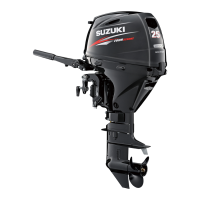2·16
PERIODIC
MAINTENANCE
CYLINDER COMPRESSION
NOTE:
Figures shown are guidelines only, not absolute service limits.
Cylinder
compression:
960-1
400 kPa (9.6
-14.0
kg/cm
2
,
137-199
psi)
Low compression pressure can indicate one or more of the fol-
lowing:
•
Excessively worn cylinder wall
•
Worn piston or piston rings
• Stuck piston rings
• Poor seating of valves
•
Ruptured or otherwise damaged cylinder head gasket
Test procedure
i.
Start and warm
up
the engine, then shut the engine off.
2.
Remove the spark plug.
3.
Install the compression gauge into the plug hole.
IMOh
09915-64512: Compression gauge
09915-63311:
Compression
gauge
adaptor
4.
Disconnect the safety lanyard from the emergency stop
switch.
A WARNING
Disconnect
the safety lanyard
from
the emergency
stop
switch
prior
to
cranking
the engine.
This
will prevent any residual fuel discharged from the
cylinder
from
being ignited
by
a
spark
discharged
from
the
spark
plug
cap.
5.
Move and hold the throttle control grip
in
the full-open posi-
tion.
6.
While cranking the engine with the recoil starter, note the
maximum compression pressure reading
on
the gauge.

